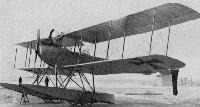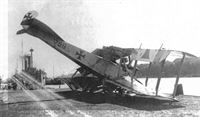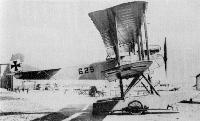
Описание
Страна: Германия
Год: 1915
O.Thetford, P.Gray German Aircraft of the First World War (Putnam)
Brandenburg NW
Thirty-two aircraft of this type were supplied to the German Navy during 1915. They were used on reconnaissance patrol duties, radio was carried and some machines were fitted with racks to carry ten 5-kg. bombs. The machine was an improvement of the pre-war W design and bore unmistakable resemblance to Heinkel's three-bay Albatros seaplanes. Engine, 160 h.p. Mercedes D III. Span, 16.5 m. (54 ft. 1 3/4 in.). Length, 9.4 m. (30 ft. 10 1/8 in.). Area, 57.85 sq.m. (625 sq.ft.). Weights: Empty, 1,020 kg. (2,244 lb.). Loaded, 1.650 kg. (3,630 lb.). Speed, 90 km.hr. (56.25 m.p.h.). Duration, 4 hr. Armament, none.
Brandenburg GNW
Further development of the NW saw the construction of sixteen GNWs during 1915 for use as unarmed two-seater patrol seaplanes. Speed was less than that of the NW, but the climb was considerably better. Engine, 160 h.p. Mercedes D III. Span, 16.2 m. (53 ft. 1 7/8 in.). Length. 9.88 m. (32 ft. 5 in.). Height, 2.553 m. (8 ft. 4 1/2 in.). Area, 55.15 sq.m. (596 sq.ft.). Weights: Empty, 1,100 kg. (2,420 lb.). Loaded, 1,743 kg. (3,835 lb.). Speed, 115 km.hr. (71.825 m.p.h.). Climb. 1,000 m. (3,280 ft.) in 9.5 min.
Описание:
- O.Thetford, P.Gray German Aircraft of the First World War (Putnam)
- C.Owers Hansa-Brandenburg Aircraft of WWI Vol.2: Biplane Seaplanes (A Centennial Perspective on Great War Airplanes 18)
- J.Herris Gotha Aircraft of WWI (A Centennial Perspective on Great War Airplanes 6)
- M.Dusing German Aviation Industry in WWI. Volume 1 (A Centennial Perspective on Great War Airplanes 84)
- E.Hauke, W.Schroeder, B.Totschinger Die Flugzeuge der k.u.k. Luftfahrtruppe und Seeflieger 1914-1918
Фотографии
-
C.Owers - Hansa-Brandenburg Aircraft of WWI. Volume 2 - Biplane Seaplanes /Centennial Perspective/ (18)
Brandenburg NW #602 of the German Kriegsmarine, early 1917.
-
C.Owers - Hansa-Brandenburg Aircraft of WWI. Volume 2 - Biplane Seaplanes /Centennial Perspective/ (18)
Brandenburg NW K148 of the kuk Kriegsmarine.
-
C.Owers - Hansa-Brandenburg Aircraft of WWI. Volume 2 - Biplane Seaplanes /Centennial Perspective/ (18)
The Albatros influence was still present in the NW. Note the red pennant on the port wing tip. Red pennants were flown by naval aircraft during the red uprising after Germany lost the war.
-
C.Owers - Hansa-Brandenburg Aircraft of WWI. Volume 2 - Biplane Seaplanes /Centennial Perspective/ (18)
"My successful Hansa-Brandenburg 487". (via AHT AL0444-206 from the album of F.Christiansen)
-
C.Owers - Hansa-Brandenburg Aircraft of WWI. Volume 2 - Biplane Seaplanes /Centennial Perspective/ (18)
Like many early floatplanes the NW had a multitude of struts to take the loads on the floats. Note the small national marking on the fuselage of MN 517.
-
J.Herris - Albatros Aircraft of WWI. Volume 3: Bombers, Seaplanes, J-types /Centennial Perspective/ (26)
Albatros W.1 Marine Number 226 appears to be a total loss. Marine Number 512 in the background is a Brandenburg FB. (517 - Brandenburg NW ???) (Peter M. Grosz Collection/SDTB)
Другие самолёты на фотографии: Albatros WDD / W.1 - Германия - 1913
-
C.Owers - Hansa-Brandenburg Aircraft of WWI. Volume 2 - Biplane Seaplanes /Centennial Perspective/ (18)
The person at the starboard wings is not thought to be walking on water but on a sand bar where this NW (518 or 519) must have run aground.
-
C.Owers - Hansa-Brandenburg Aircraft of WWI. Volume 2 - Biplane Seaplanes /Centennial Perspective/ (18)
MN 523 taxiing. The NW was an ungainly looking seaplane.
-
C.Owers - Hansa-Brandenburg Aircraft of WWI. Volume 2 - Biplane Seaplanes /Centennial Perspective/ (18)
NW 524 was from the same batch as 517 but in this case the cross was marked ahead of the Marine Number. Details of this incident are not known.
-
M.Dusing - German Aviation Industry in WWI. Volume 2 /Centennial Perspective/ (85)
Norderney. There are at least eight floatplanes in this line up. NW 525, and Friedrichshafen FF 33E 715 and 727 can be identified.
Другие самолёты на фотографии: Friedrichshafen FF33 - Германия - 1915
-
C.Owers - Hansa-Brandenburg Aircraft of WWI. Volume 2 - Biplane Seaplanes /Centennial Perspective/ (18)
Brandenburg NW floatplanes lead this line up on the slipway with Friedrichshafen FF33L MN 1239 at the rear.
-
J.Herris - German Seaplane Fighters of WWI /Centennial Perspective/ (2)
Friedrichshafen FF33L Marine Number 1009 is at the far right with FF33L Marine Number 1239 in front of it on the ramp.
Другие самолёты на фотографии: Friedrichshafen FF33 - Германия - 1915
-
C.Owers - Hansa-Brandenburg Aircraft of WWI. Volume 2 - Biplane Seaplanes /Centennial Perspective/ (18)
MN 602 from the fourth batch of NW floatplanes ordered.
-
M.Dusing - German Aviation Industry in WWI. Volume 1 /Centennial Perspective/ (84)
Gotha WD6 (HaBra NW(Go)) (1916)
-
J.Herris - Gotha Aircraft of WWI /Centennial Perspective/ (6)
A Gotha-built NW in the Gotha testing pond. The streamlined undercarriage strut fairings are noteworthy.
The Brandenburg NW was built under license by Gotha as the Brandenburg NW(Go). Gotha built 30 of these floatplanes that were given the internal Gotha company designation WD6. -
C.Owers - Hansa-Brandenburg Aircraft of WWI. Volume 2 - Biplane Seaplanes /Centennial Perspective/ (18)
Brandenburg NW(Go) Marine #759 was destroyed landing at Libau on 15 June 1917. Note the style and size of the national markings.
-
J.Herris - Gotha Aircraft of WWI /Centennial Perspective/ (6)
Brandenburg NW(Go) Marine #763 getting a lift. This seaplane was destroyed at Putzig on 12 August, 1918, when a student pilot was killed in a flying accident. Was this the event pictured?
-
C.Owers - Hansa-Brandenburg Aircraft of WWI. Volume 2 - Biplane Seaplanes /Centennial Perspective/ (18)
The sole Austro-Hungarian kuk Kriegsmarine NW, serial K148. Note the position of the cross on the upper surface of both wings.
-
C.Owers - Hansa-Brandenburg Aircraft of WWI. Volume 2 - Biplane Seaplanes /Centennial Perspective/ (18)
A fine study of an NW biplane in flight.
-
C.Owers - Hansa-Brandenburg Aircraft of WWI. Volume 2 - Biplane Seaplanes /Centennial Perspective/ (18)
GNW MN 627 survived into 1918 to receive the straight sided crosses.
-
M.Schmeelke - "Torpedo Los!" /Aeronaut/
Brandenburg NW 755 in Flensburg. (KMF)
-
M.Schmeelke - "Torpedo Los!" /Aeronaut/
Brandenburg NW (755) was recovered following its landing accident in Flensburg.
-
C.Owers - Hansa-Brandenburg Aircraft of WWI. Volume 2 - Biplane Seaplanes /Centennial Perspective/ (18)
Brandenburg NW SVK Drawing
-
C.Owers - Hansa-Brandenburg Aircraft of WWI. Volume 2 - Biplane Seaplanes /Centennial Perspective/ (18)
Brandenburg GNW SVK Drawing
-
C.Owers - Hansa-Brandenburg Aircraft of WWI. Volume 2 - Biplane Seaplanes /Centennial Perspective/ (18)
Brandenburg GNW Factory Drawing































